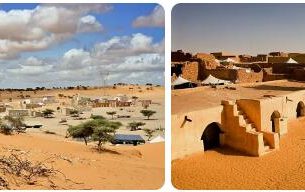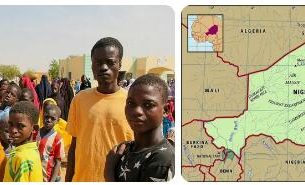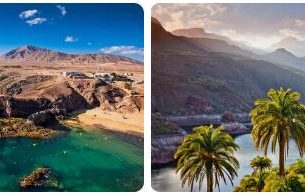Central African Republic, State in Inner Africa. Most of the country is covered with wet savannah; tropical forests grow in the south and along the rivers. The main livelihood of the population (predominantly Sudanese peoples) is agriculture. Export goods are coffee, diamonds, wood, cotton and tobacco.
History: The country was a French colony under the name Ubangi-Shari from the end of the 19th century. In 1960 it became an independent republic, from 1976–79 it was an empire, and since then it has been a republic again.
Country facts
- Official name: Central African Republic
- License plate: RCA
- ISO-3166: CF, CAF (140)
- Internet domain:.cf
- Currency: CFA franc
- Area: 622,980 km²
- Population (2019): 4.7 million
- Capital: Bangui
- Official language (s): Sango, French
- Form of government: Presidential Republic
- Administrative division: 16 prefectures and capital district
- Head of State: President Faustin-Archange Touadéra (since March 30, 2016)
- Head of Government: Firmin Ngrébada (since February 25, 2019)
- Religion (s) (2010): 90% Christian; 9% Muslim, 1% followers of traditional local religions
- Time zone: Central European Time
- National holiday: December 1st
Location and infrastructure
- Location (geographical): Central Africa
- Position (coordinates): between 2 ° and 11 ° north latitude and 14 ° 30 ‘and 27 ° 30’ east longitude
- Climate: Humid tropical savanna climate
- Highest mountain: Mont Ngaoui (1,410 m)
- Road network (2018): 700 km (paved), 23,300 km (unpaved)
Population
- Annual population growth (2020): 2.1%
- Birth rate (2020): 33.2 per 1000 residents.
- Death rate (2020): 12.3 per 1000 residents.
- Average age (2020): 20 years
- Average life expectancy (2020): 54.2 years (men 52.7; women 55.7)
- Age structure (2020): 39.5% younger than 15 years, 3.4% older than 65 years
- Literacy rate (15 year olds and older) (2018): 37.4%
- Mobile phone contracts (pre-paid and post-paid) (2018): 27 per 100 residents
- Internet users (2017): 4 per 100 residents
Economy
- GDP per capita (2019): US $ 448
- Total GDP (2019): $ 2.321 billion
- GNI per capita (2018): US $ 490
- Education expenditure (2011): 1.1% of GDP
- Military expenditure (2019): 1.5% of GDP
- Unemployment rate (15 years and older) (2019): 3.7%
National symbols
The national flag was introduced in 1958 and adopted unchanged after independence on August 13, 1960. It is horizontally striped in four equal stripes blue over white over green over yellow. In the middle there is a vertical red stripe over all horizontal stripes, which is just as wide as the other stripes are high. In the upper corner there is a yellow five-pointed star as a symbol for freedom. Blue, white and red are reminiscent of French colonial rule, while red, yellow and green are the African colors.
The coat of arms was introduced on May 17, 1963. It shows a silver elephant’s head in the four-sided shield in the first, green field, in the second, silver field, a tree (symbols for fauna and flora of the country), in the third, gold field, three silver-pierced, black four-pointed stars, in the fourth, blue field one human hand; in the red heart sign the black silhouette of the African continent, topped with a gold star. The rising sun rests on the shield (in it the date “December 1, 1958”), and above it hovers a tape with the slogan “Zo Kwe Zo” (human is equal to human). The jewel of the National Order of Merit hangs on the top of the shield, as well as another ribbon with the motto “Unité, Dignité, Travail” (unity, dignity, work). There are two crossed national flags behind the shield.
The national holiday is December 1st, it commemorates the declaration of internal autonomy within the framework of the French community in 1958.
Location
The Central African Republic borders Chad to the north, Sudan to the northeast, South Sudan to the east, the Democratic Republic of the Congo and the Republic of the Congo to the south, and Cameroon to the west.
The country extends north of the Ubangi River in the area of the Asande threshold, which separates the Chad Basin from the Congo Basin. Precambrian gneiss, quartzite and slate, on which Cretaceous sandstones are laid discordantly in the Lobaye and Haute-Kotto areas, form a flat, undulating, deformed hull surface at 500–1,000 m above sea level, which is located in the northeast of the Bongo massif (in Mont Toussoro 1,330 m above sea level) and in the northwest by the foothills of Adamaua (in Mont Ngaoui 1,410 m above sea level). The north-west of the country lies in the catchment area of the Shari, the main part of the country is drained to the south to the Ubangi.
Climate
The largest part has a humid tropical climate with a large and a small rainy season; there is a pronounced dry season of four months in the northwest and more than six months in the northeast. The extreme southwest, on the other hand, always has a humid tropical climate. The annual total of precipitation decreases from 1,400 to 1,500 mm in the entire south to 1,200 mm in the central and 880 mm in the extreme north. The mean temperatures in the south are between 24 and 27 ° C, in the north they reach 24–25 ° C in the rainy season and 29–30 ° C in the dry season. Typical for the main rainy season are daily thunderstorms and the extraordinary humidity. Visit barblejewelry.com for Africa annual rainfall.
Vegetation
In the southwest there is tropical rainforest, in the central main part wet savannah with gallery forests, in the northeast dry savannah (in very dry locations with baobab and fan palm). The Manovo-Gounda Saint Floris National Park (UNESCO World Heritage Site) in the north encompasses 17,400 km 2 of three vegetation zones with a large number of species of flora and fauna that are worth protecting.



